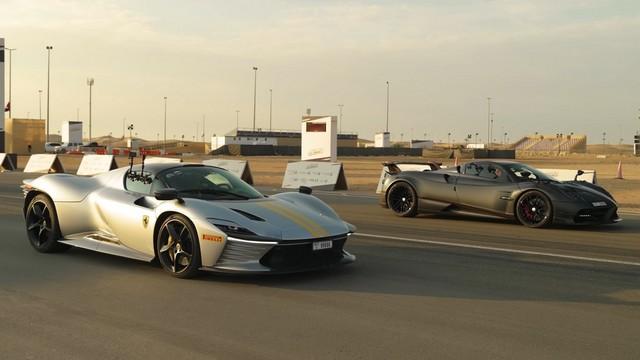In the ever-competitive realm of hypercars, the drag race is no longer merely a test of speed—it has evolved into a theater of engineering, philosophy, and identity. Few matchups embody this shift more perfectly than the clash between the Ferrari Daytona SP3 and the Pagani Huayra. This is not just a matter of horsepower and aerodynamics—it is a duel of legacies, of radically different design doctrines, and of contrasting visions of what performance means in the twenty-first century.
This piece explores in depth the cultural, mechanical, and aesthetic significance of this head-to-head, unpacking not just which car wins in a straight line but what each car means—for the brands behind them, for the rarefied world of automotive excellence, and for the aficionados who measure time in revs and memory in seconds shaved.
Prancing Horse, Futuristic Retro: The Ferrari Daytona SP3
When Ferrari unveiled the Daytona SP3 in 2021, it was met with both awe and historical curiosity. As part of the ultra-exclusive “Icona” series—a line that pays homage to Ferrari’s racing heritage while leveraging cutting-edge technology—the SP3 is deeply rooted in the past while racing straight into the future. It references the Ferrari 330 P4 and 412 P that dominated the 1967 24 Hours of Daytona, yet it does so not through nostalgia, but through architectural reincarnation.
The SP3, limited to just 599 units, houses a naturally aspirated 6.5-liter V12 engine—the same block as the 812 Competizione but reengineered for mid-rear placement. Producing 829 horsepower and 514 lb-ft of torque, this engine revs to a celestial 9,500 rpm. There is no hybrid assistance, no turbocharging—just a purist expression of combustion engine artistry. Paired with a seven-speed dual-clutch transmission and wrapped in a sculptural carbon-fiber body, the SP3 is Ferrari’s statement of resistance against the hybrid tide.
Its acceleration numbers are formidable: 0-100 km/h (62 mph) in 2.85 seconds, 0-200 km/h in 7.4. But Ferrari insists the SP3 is more about the driving experience than numbers. Indeed, its naturally aspirated V12 creates a crescendo that evokes classical music more than machine noise. The cabin is minimalist yet race-focused, with fixed seats and adjustable pedals, echoing Le Mans interiors. It is, in every aspect, a driver’s car—one designed for sensation, not convenience.
Pagani Huayra: The Baroque Turbo Futurist
Where Ferrari trades in heritage, Pagani plays in metaphysical rebellion. Horacio Pagani, once a disciple of Leonardo da Vinci’s “art meets science” ethos, birthed the Huayra as a successor to the Zonda in 2011. Over the years, multiple variants—Huayra BC, Huayra Roadster, Huayra Imola—have refined the original formula. The Huayra is less a car and more a philosophical object, born of obsessions with materials, aerodynamics, and emotionality.
Unlike the Ferrari, the Huayra is turbocharged—its 6.0-liter V12, sourced from Mercedes-AMG, generates 730 to 827 horsepower (depending on version) and a staggering 811 lb-ft of torque. That torque curve is accessible early, courtesy of twin turbochargers, enabling brutal launches and mid-range surges that feel almost anti-physical. The transmission is a 7-speed single-clutch Xtrac gearbox—less refined than Ferrari’s DCT but lighter, in line with Pagani’s minimalist weight ethos.
The car’s name, “Huayra,” comes from a South American wind god—a clue to its hyper-aerodynamic design. Active aero flaps and a teardrop cabin shape create a car that breathes with the road. Yet despite its technological sophistication, the Huayra retains a baroque opulence: interiors lined in quilted leather, exposed gear mechanisms, titanium bolts shaped like jewelry. It is an expression of excess executed with artisanal finesse.
In terms of performance, the Huayra accelerates from 0 to 100 km/h in about 2.8 seconds, nearly identical to the Ferrari. But while the SP3 builds power through rising revs, the Huayra delivers it in tidal waves of torque from 2,000 rpm onwards. It is brutish, theatrical, and immediate.
Drag Race Dynamics: Power, Weight, and Response
On paper, a drag race between the Ferrari SP3 and the Pagani Huayra seems evenly matched. Both cars hover around the 2.8-second mark for 0–60, both breach the 800 hp barrier, and both prioritize lightweight construction—Ferrari at approximately 1,485 kg dry, Pagani slightly under 1,400 kg in some trims.
Yet these two machines take diametrically opposed paths to speed. Ferrari depends on high-revving natural aspiration and razor-sharp throttle response; it must be driven with precision, its powerband explored like a musical composition. Pagani, in contrast, serves its force like an uppercut—it’s there immediately, urgent, irresistible.
In a real-world drag scenario—quarter-mile on an even surface—the Huayra’s torque and turbocharging often grant it the initial edge. It launches with less drama and more immediacy. However, the SP3, once on cam and past 6,000 rpm, becomes a slingshot of escalating aggression. The SP3’s dual-clutch gearbox also offers cleaner, faster shifts than the Pagani’s single-clutch system, which, while lighter, is less fluid in a straight-line application.
Results from multiple independent sources and unofficial head-to-heads suggest that the Huayra might edge out the SP3 in a traditional drag race by tenths of a second. But the Ferrari claws back in longer races or on twistier routes, where throttle modulation, weight distribution, and aerodynamics matter more than brute force.
Aesthetics as Argument: Design Languages in Conflict
Perhaps the most captivating aspect of this matchup lies in how each car looks—because those appearances are statements about why they were built.
The SP3 is sinewy, muscular, sculpted like an athlete mid-motion. Its haunches bulge with restrained aggression, its flying buttresses and dorsal spine reminiscent of prototypes from the golden age of endurance racing. There’s a clarity to it—a singular intent.
The Huayra, on the other hand, is a labyrinth of forms. Its front fascia is alien, its body a constant play of convex and concave. Even its exhaust system, a quad of centrally-mounted titanium trumpets, is designed to induce aesthetic awe. Where the Ferrari whispers precision, the Pagani sings extravagance.
This divergence in design reflects deeper ideological distinctions. Ferrari, ever rooted in racing, emphasizes function sculpted into beauty. Pagani pursues beauty as function—every bolt, every weave of carbon fiber, part of an emotional, aesthetic whole. The SP3 is born from track legacy; the Huayra from a designer’s sketchpad fever dream.
Literary and Philosophical Echoes
From a literary perspective, one might see the Ferrari SP3 as a character from Hemingway—lean, efficient, purposeful, driven by honor and history. The Pagani Huayra, meanwhile, belongs to the realm of Borges or Calvino—complex, poetic, contradictory, reveling in the irrationality of human desire.
Ferrari appeals to the purist, the driver who sees control and precision as ultimate virtues. Pagani appeals to the dreamer, who values emotional resonance over mechanical restraint. In many ways, the SP3 is Apollonian, the Huayra Dionysian—a classical opposition that resonates through centuries of art and storytelling.
The Road Ahead: Electric Horizons and Legacy Machines
As the automotive industry pivots toward electrification, both Ferrari and Pagani face uncertain futures. Ferrari has begun its hybrid evolution with the SF90 and 296 GTB. The SP3, then, is almost a swan song—a final, defiant celebration of the naturally aspirated V12, unburdened by turbo or battery.
Pagani, too, is confronting change. Horacio Pagani has expressed reluctance toward full electrification, citing a fear of losing the “soul” of the automobile. His cars are not merely transport but “rolling sculptures.” Still, regulations are regulations, and change looms.
This makes the drag race between the SP3 and the Huayra feel almost mythic—a battle between the last great fire-breathers, unfettered by silence or software. It’s not just about which is faster. It’s about what we are about to lose.
Flow
So who wins? In raw drag race numbers, the Pagani Huayra likely edges out the Ferrari Daytona SP3. But that result is narrow and perhaps beside the point.
Ferrari’s SP3 is a masterclass in balance, a paean to purity, and a mechanical ode to a heritage that refuses to die quietly. Pagani’s Huayra is a whirlwind of sensual excess, an artwork that travels 200 mph, and a triumph of emotion over orthodoxy.
Each car defines a pole in the spectrum of automotive art. To witness them race is to see two philosophies collide—Apollo and Dionysus, Hemingway and Borges, wind and fire.
In the end, the real victory belongs not to stopwatch times or top speeds, but to the continued ability of cars like these to inspire awe, debate, and reverence in an age increasingly dominated by algorithms and automation.
No comments yet.








